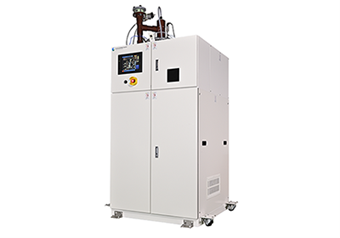Taiyo Nippon Sanso Corporation (Headquarters: Shinagawa-ku, Tokyo; President Kenji Nagata; hereinafter "TNSC"), a Japanese industrial gas business company in the Nippon Sanso Holdings Group, began selling an exhaust gas abatement system for the semiconductor industry this April that uses hydrogen (H2) gas as a fuel and does not emit any fuel-derived greenhouse gases. TNSC will continue to develop and market optimal exhaust gas abatement systems to meet the evolving needs of the times, including global efforts to achieve carbon neutrality.
News Release PDF

Appearance of Blisters Burner H2
1. Development Background
Japan's Basic Energy Plan calls for electrification with decarbonized electricity, or the use of decarbonized energy sources, such as hydrogen, synthetic methane, and synthetic fuels, in processes that are challenging to electrify. Against this backdrop, it has been challenging to electrify semiconductor manufacturing processes that use special material gases, such as SiH
4, for film deposition because of the generation of powder during exhaust gas treatment.
We used our technology to solve this issue. Being a manufacturer of GaN-MOCVD equipment, we have also launched a combustion-type exhaust gas abatement system, Hercules Burner, which serves as the auxiliary equipment. This system uses only H
2 gas as a fuel and decomposes NH
3 gas by efficiently burning H
2 gas in the process exhaust. The technology underlying this system is utilized in Blisters Burner H
2.
2. Features and Structure of the System
We have marketed combustion-type exhaust gas abatement systems for the semiconductor industry for some time, and now we announce the launch of Blisters Burner H
2, a combustion-type exhaust gas abatement system using only H
2 fuel, as a non-fossil fuel-based product.
The system consists of a burner section, a primary cooling section, and a secondary cooling section (scrubber section), as shown in Fig. 1. Gases discharged from semiconductor manufacturing equipment are introduced into the burner section and heated for decomposition. Inside the burner, cooling air is supplied to prevent corrosion of components and adhesion of secondary product powder, increasing the stability of the system for continuous operation.
The primary cooling section rapidly cools the high-temperature process gas, and the scrubber section provides final gas cooling and cleans and removes water-soluble gases, such as HF and HCl, which are by-products of the process gas.

Fig. 1 Schematic diagram of hydrogen combustion-type exhaust gas abatement system
This system exploits the potential of H
2 gas combustion by effectively contacting and mixing a hydrogen flame with the process gas, thereby achieving a burner structure that can treat exhaust gas other than H
2-rich exhaust gas. An evaluation showed that energy savings of 30% to 50% have been achieved in the PFC* decomposition process compared to conventional combustion processes using fossil fuels.
Another feature of this product is that it is designed to convert to H
2 fuel specifications with only minor modifications from the existing Blisters Burner, which uses conventional fossil fuels. This feature anticipates future increase in the demand for H
2 fuel.
Blisters Burner H
2 can be a useful option for achieving carbon neutrality in the coming hydrogen society, as it is based on our rich sales experience and expertise gained from Hercules Burner, an exhaust gas abatement system that uses only H
2 fuel.
*PFCs, or perfluorocarbons, are chemical compounds in which carbon and fluorine are bonded together.
Taiyo Nippon Sanso Corporation
Tnsc.Info@tn-sanso.co.jp